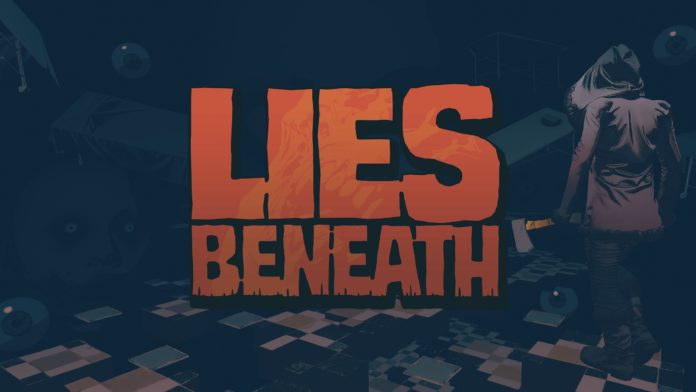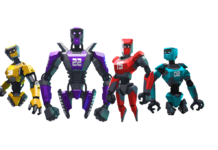Oculus Quest owners could be forgiven for feeling a little left out lately, forced to look on in envy as PC VR owning players got to enjoy a trio of excellent creepy thrill rides in Boneworks, Walking Dead: Saints and Sinners and the incredible Half-Life Alyx.
Well, Questers sulk no more, veteran VR developers Drifter (Gunheart and Robo Recall: Unplugged) has just blessed the platform with an exquisitely unpleasant game, a horror survival thrill ride that actually made me feel a lot more on edge than all three of the games above.
Quest Comes First
Lies Beneath will soon also release for PC VR, supporting cross-buy as is always the case for titles produced in collaboration with Oculus Studios. This is, of course, nice, but make no mistake this is very much a game designed first and foremost for the Oculus Quest. This means taking into account its power limitations but also playing to its great strength, untethered wireless freedom, and the joy of unrestricted movement.
Visuals and Audio
The Quest is simply not capable of rendering realistic graphics and complex environments like a powerful PC can, so the team at Drifter have cleverly gone for a deliberate comic book art style, that both gives the game a unique and stylish character, and eliminates the need for dynamic lighting effects and a high polygon count. They’ve also kept the game intentionally dark and claustrophobic, easing the burden on the Quest’s humble graphics chip, but also ramping up the tension as you blindly stumble and grope around in the dark, unnerved by an ominous sound you can’t quite pinpoint the location of and a pair of red eyes in the distance that belongs to God knows what…
The sound is fantastic throughout. If you’re brave enough you simply have to listen with headphones, it ratchets up the fear factor considerably. The musical score reminded me of many of the best Game of Thrones White Walker scenes and being set largely at night, in frozen, snowy Slumber, Alaska it elicits a similar dread. All of the game’s mutants have distinctive cries, a bloated pig creature being a particular standout, it’s squealing so intense I had to turn my headphones down.
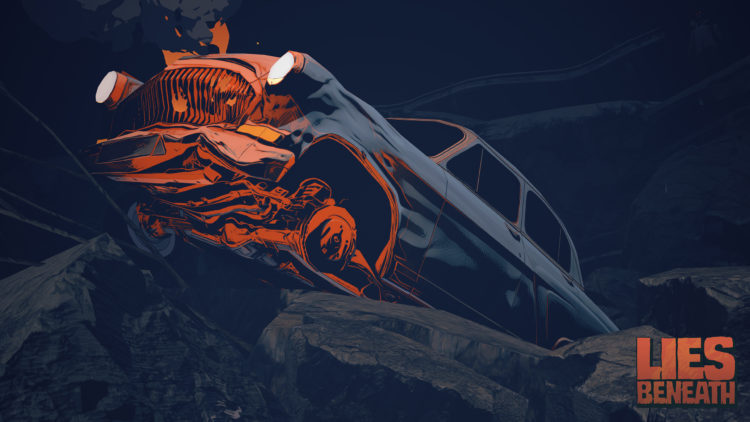
Gameplay
The gameplay is simplified too to ensure a consistent playable experience. There’s certainly no complex physics, attacks lead to simple canned animations rather than a realistic ragdoll effect. I read a review that criticized the game for this in comparison to recent top PC VR releases but I think this is unwarranted negativity. With its art style, the game simply doesn’t need that level of realism and in stripping down the experience we have a game that runs very well on the Quest indeed.
And whilst the combat mechanics might be simplified, this is not to say they aren’t fun. There’s a clever mix of melee weapons and guns, which alongside the ability to pick up and reuse animal traps and flammable cans of kerosene, invites the player to approach situations according to their own style. The pump-action shotgun delivers devastating stopping power but needs to be loaded one bullet at a time, the ax is great fun and ideal for throwing, but frustrating if it gets stuck in a mutants skull whilst they are still alive and you now have no weapon to fight with!
There are some wonderful set-piece battles, including an excellent cabin in the woods moment where you fight off hordes of monsters climbing through the windows and breaking down the doors. If you’re a fan of the Evil Dead films or the classic werewolf horror Dog Soldiers, you’ll know exactly the kind of scene I’m describing.
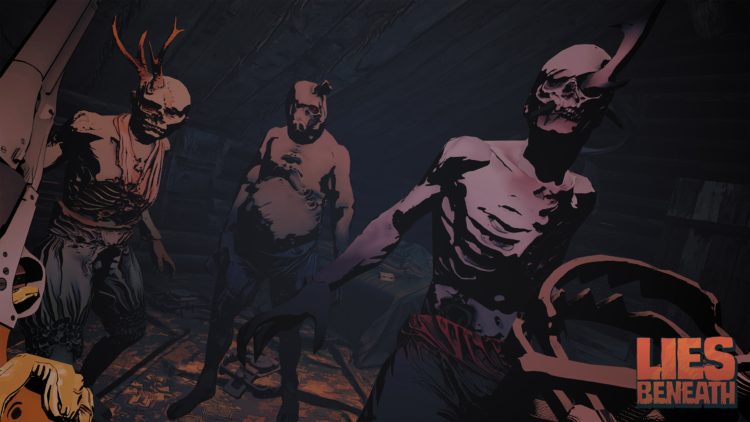
Most crucially for this genre, the horror elements are really well done. The game manifests fear using a variety of tropes, nearly all of them which were effective on me. It wasn’t so scary that I couldn’t play, but I certainly felt unsettled through large periods of the gameplay. Without giving too much away if you’re afraid of the undead, monsters, the dark, tightly enclosed spaces, deep water, torture, being chased and pursued, or trapped and surrounded then this is a game that will give you the shivers.
The level design works really well with the Quest’s wireless freedom. How often do you hear PC gamers moan about the lack of a smooth turning option? It’s even happened with Half-Life Alyx. Not so with Lies Beneath. Whilst this game has a commendable plethora of locomotion options, including smooth turn I found I barely needed to use them. I just set it to joystick locomotion controlled by head movement, and physically turned myself. In this game, you’ll find yourself spinning around a lot, and providing you have a big enough play space, of course, being able to initiate all turns with your own body makes for both a more active experience and a more visceral one.
Set over 20 chapters the game is fairly long for a Quest title, probably taking 6 to 8 hours depending on the difficulty level you play at but save points are scattered liberally, lighting fires and lanterns acting as checkpoints to respawn at if you die. And die you will, if not directly from mutants killing you, then simply drowning when the ice you’re standing on cracks beneath your feet. I found I had to retry a few sections several times to get past them, which is good if you want a challenge.
It’s not all perfect of course. Like any game, there are some minor problems here. I found that the screen would often go black for a moment if I went too close to my boundary walls and the guardian activated. A couple of times when returning from the menu option my height increased and I had to play the rest of the chapter as if I was nine feet tall. It would correct itself at the next checkpoint but it was annoying. I’ve never experienced this with a Quest title before, but can’t rule out hardware rather than software error of course.
Active fitness potential
(Ordinarily, when reviewing a fitness-focused game we use a specific template and playtest with a heart rate monitor. For fully-fledged games that might involve story development, puzzle-solving, exploration, and character conversations such an approach isn’t possible. So instead when reviewing mainstream game releases that have active components a more descriptive and generalized overview is appropriate.)
As a fitness-focused website here at VRFI we obviously want to make our games as active as possible. In terms of physical activity, this game is low to moderate depending on your play style. It’s possible to play the game very passively and not to move much at all. Attack animations are canned, rather than weighted so the slightest of hand gestures will have the same result. You can also push a button to turn around and stick to gunplay to barely raise your pulse.
Of course, we aren’t going to recommend playing like that! You can get a moderate workout going but you’ll need to get a little creative.
Mirror your character’s pace
Walking and jogging on the spot in sync to your character’s movement is a tried and tested way of getting your heart rate up. Not only that but with a bit of practice, it can actually immerse you more into the game and help to reduce motion sickness, if you’re susceptible to it.
To use this technique you’ll need to select full locomotion, teleport movement won’t work as you won’t have any movement to mimic. You also need to choose between head or controller led tracking. I find head tracking works best. This way you can push forward on the joystick to move, walk or jog on the spot and steer by looking in the direction you want to go.
Take advantage of the wireless freedom
If you want to turn around, don’t use snap or smooth turn, move your body! As the action in this game takes place all around you, physically turning yourself will give you a much more active experience.
Pick up your weapons
If you are standing over a weapon or item you can force grab it off the floor. But don’t be lazy. Physically bend down and pick it up!
Fight with gusto
The game may not utilize force weighted physics, but there’s nothing to stop you from acting as if it does. Swing that ax like you’re trying to do damage, (after responsibly clearing your play space of course) and pump that shotgun as if a polar bear is charging you at full speed.
Following these steps might not give you the same workout you’d get playing BoxVR, but you’ll certainly be working hard enough to alleviate any guilt over the fun you’re having from enjoying this must play Quest title.
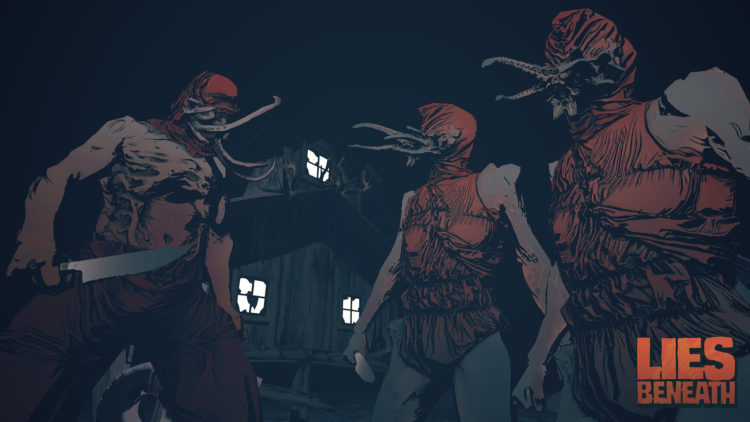
Summary – An Oculus Quest classic
9/10 game rating 6.5/10 fitness rating
Evaluating this Oculus exclusive calls for some perspective. As a PC VR Oculus Rift title, it’s simplistic in comparison to the recently released heavyweights such as Saints and Sinners and Half-Life Alyx. But Lies Beneath is clearly a game designed with the mobile VR market in mind.
Judged on those merits it’s a fantastic, single-player, story-driven fright fest that hooks from its opening moments, and doesn’t let go until the very end. Just like Journey of the Gods was a wonderful Asgard’s Wrath lite for mobile VR users, so Lies Beneath will give Quest gamers looking for an epic Half-Life type horror survival adventure exactly what they want. With so much of the Quest’s catalog consisting of family-friendly, if not outright childish offerings it’s really refreshing to get a truly adult Quest adventure to play through.
If you own a Rift S or other PC VR headset this game looks and plays a little basic. However, this is a gem of a Quest game and absolutely recommended.
The Good
Stylized horror game with a unique comic book look
Excellent pacing builds tension, culminating in some satisfying set-piece battles
Stunning audio, great musical score, and ominous sound effects
One of the very best Oculus Quest games you can buy
The Bad
A couple of bugs: a random black screen and sudden height increase suggest the need for a patch fix.
Clearly designed more for the mobile VR market rather than PC.
Lies Beneath is an Oculus exclusive title out now on the Oculus Quest store for $29.99 or £22.99. It will release for the Oculus Rift next month, and will likely be playable on non-Oculus headsets via Revive.

